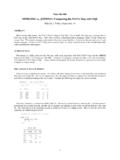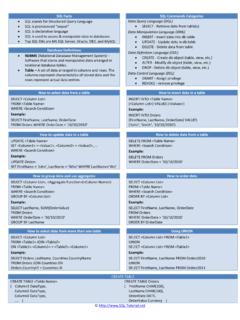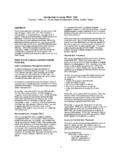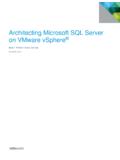Transcription of SQL Server DBA Training - Andrew Fraser DBA
1 SQL Server DBA Training Andrew Fraser , September 2010, This course is a reduced version of Microsoft s 5 day System Administration for Microsoft SQL. Server course. It focuses on the differences between SQL Server and Oracle and on the main SQL Server tasks a DBA team is likely to have to perform: Installs; Service Access Requests;. Cloning; Backups; Restores; Datafile maintenance. DBA tasks which are out of scope for this course are upgrades and performance tuning. These notes apply to version SQL Server 2008 Release 2. Table of Contents 1. SQL Server Overview .. 2. 2. Installing and Configuring SQL Server .. 3. 3. Security .. 9. 4. Managing Database 11. 5. Backup .. 13. 6. Restore .. 15. 7. Automating Administrative Tasks with Jobs and Alerts .. 18. 8. Transferring Data with SSIS .. 19. 9. Monitoring Tools .. 20. 10. Maintenance 21.
2 11. Replication .. 26. 12. High Availability .. 27. Appendix A List of Differences between SQL Server and Oracle .. 31. Appendix B Installation With Screenshots .. 33. SQL Server DBA Training 1. SQL Server Overview SQL Server was originally the Microsoft rebadged version of the Sybase relational database. It is only available on Windows platforms. Current version (July 2010) is SQL Server 2008 R2. The two principal differences between SQL Server /Sybase and Oracle are: 1. SQL Server has no undo or rollback segments and therefore no rollback/commit functionality, or read consistent data views; other than what little can be accommodated from the on line redo logs. 2. SQL Server architecture is: 1 host machine to 1 or more Instances to many Databases. There is no such thing as a tablespace within SQL Server . On line redo logs exist at database level.
3 A more complete list of differences is given in Appendix B. SQL Server does not offer an equivalent to RAC. There are SQL Server equivalents to dataguard and replication, and SQL Server does offer database mirroring and failover clustering. Note that SQL commands are not executed by ; or / as in oracle, but with go. SQL Server is mostly managed from the SQL Server Management Studio (similar to Oracle Enterprise Manager and was called Enterprise Manager in older versions). The exception is the optional components (below) are instead managed from the SQL Server Business Intelligence Development Studio (which is a cut-down version of Microsoft Visual Studio). Stopping and Starting SQL Server is done with SQL Server Configuration Manager (Start > All Programs > Microsoft SQL Server 2008 R2 > Configuration) or, less correctly, SQL Server has optional components which come at no extra cost (if hosted on same machine): SQL Server Reporting Services Business Intelligence reporting, Microsoft s alternative to OBIEE, Discoverer, Crystal Reports.
4 Has very good integration with Microsoft client products such as Excel which is a significant for end-user usability. Analysis Services OLAP (on line analytical processing), cubes, data mining. SQL Server Integration Services ETL (extract transform load) and export/import tools. Is equivalent to export/import, data pump, sql loader, DBA shell scripts. This was called DTS. (Data Transformation Services) in older versions. Version History: Name Number Release Date Sybase - - SQL Server 1996. SQL Server 7 1998. SQL Server 2000 2000. SQL Server 2005 2005. SQL Server 2008 2008. SQL Server 2008 Release 2 2010. Page 2 of 48. SQL Server DBA Training 2. Installing and Configuring SQL. Server Installation Unlike Oracle, Microsoft do not make their software available for download. It is instead typically supplied in a pack of Microsoft DVDs with licence codes preloaded.
5 In most organisations these DVDs are controlled by the Windows Sys Admin team it is often a good idea to keep a of copy the SQL Server installation software to a secure network share. DBAs Service packs (patchsets) are made available for download on , without the need for support login credentials in contrast to oracle patchsets. Which Edition do I Install? SQL Server comes in many more editions than Oracle does, although it does avoid Oracle s long list of extra cost options. A common practice for a mixed Oracle/SQL Server site to adopt would be: Express Edition for desktop PCs, dev/test servers, small production servers. Standard Edition for all other systems. Enterprise Edition not used instead host systems that large in Oracle. Two free versions of SQL Server are available for download at 180 day trial/evaluation edition fully functional, until the end of the time period when it will stop running altogether and display this message: Evaluation period has expired.
6 For information on how to upgrade your evaluation software please go to ( ) . Express edition Has most functionality except is limited to 10gb of data and the use a single CPU and 1gb of RAM. CPU here means a physical CPU multiple cores are ok. Unlike oracle express edition, service packs are made available. This can often be a good option for dev/test, and even for small production databases. Express Edition has a number of technical restrictions which make it undesirable for large-scale deployments, including: maximum database size of 4 GB per database (2005 version) or 10 GB (2008 and 2008. R2 versions) (compared to 2 GB in the former MSDE). The limit applies per database (log files excluded); but in some scenarios users can access more data through the use of multiple interconnected databases. hardware-utilization limits: o Single physical CPU, multiple cores o 1 GB of RAM (runs on any size RAM system, but uses only 1 GB).
7 Absence of the SQL Server Agent service Although its predecessor, MSDE, generally lacked basic GUI management tools, SQL Server Express includes several GUI tools for database management. These include: SQL Server Management Studio Express SQL Server Configuration Manager SQL Server Surface Area Configuration tool SQL Server Business Intelligence Development Studio. Page 3 of 48. SQL Server DBA Training Features available in SQL Server "Standard" and better editions but absent from SQL Server Express include (for example): Analysis Services Integration Services Notification Services The below variants of Express edition install are available for download. The DBAs life is made easier if the management studio is installed along with the database. For both trial and express editions, it is possible to upgrade to a licensed edition with a valid license code.
8 For SQL Server 2005 this required setting a command line parameter ( SKUUPGRADE=1 ), but that requirement has been removed with SQL Server 2008. Licensed Editions Standard Edition and Enterprise Edition In contrast to oracle environments, standard edition is much more commonly used than enterprise edition. Standard Edition is limited to 4 CPUs. It will install on machines with more CPUs, but will not make use of the extra CPUs. With that exception, and unlike oracle standard edition, it has almost all of the features of enterprise edition, including failover clustering, replication, database mirroring. 4 CPUs here means 4 physical CPUs potentially many more than 4 cores. Enterprise Edition has no CPU limitation. Partitioning and indexed views are only available with Enterprise Edition. Snapshot and Transactional replication for Oracle are also only available with Enterprise Edition.
9 Those are all features associated with data warehouses. Backup compression is also Enterprise Edition only. ( ). Enterprise edition licenses cost four times the price of standard edition licenses. ( ). Page 4 of 48. SQL Server DBA Training Note that on virtual servers, each Standard Edition virtual processor is licensed as if it was a physical processor. This makes virtual servers very expensive, and unnecessarily so, since the different databases could just be hosted as separate databases in a single physical SQL Server instance. SQL Server Enterprise Edition however allows virtual servers to run for free on top of a licensed physical Server . Another option for a virtual environment would be to pay for Client User Access Licensing instead of Processor Licensing. Multicore processors are treated as a single processor for licensing purposes, unlike with Oracle which applies a multiplying factor.
10 Passive DR servers, such as for database mirroring or failover clustering, do not require licensing. Supported Operating Systems: Windows Server 2008. Windows Server 2003. XP, Vista, Windows 7. Installation Server build If possible, use 64 bit Windows Server 2008 with latest operating system service packs applied. Normally executable program files will be installed into C: drive, while database files would be kept on SAN storage mapped as a D: drive. For critical high performance databases, an additional SAN array would be used (mapped as E: drive) to separate data files from transaction log files. You require local admin rights for the install, but you do not need any special domain rights. Installation Carry out all the following in a temporary directory (like c:\junk) that you can delete once the installation is complete.





